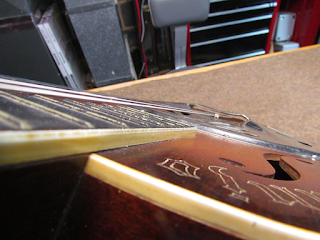
Oh, look! Another old instrument case on the bench. Wonder what's inside.
How cool is this? It's a 1930s resonator guitar. And...it's a tenor! Pretty rare bird, I'd say.
Here's the headstock. Four strings and no waiting. No decal, no label, nothing.
Dig the rope strap.
This guitar belongs to a friend who has entrusted me to go over it. It needs a neck reset and a refret. I'm also installing new planetary tuners.
The description online in the listing was: "This item was purchased at an auction in Kentucky and was said to be custom made by Rudy Dopyera for Banjo Bill Cornett."
I had to research to find out more and to see if I could validate these claims.
Rudy Dopyera was one of the five Dopyera brothers who left National in the late 1920s over disagreements with its President, George Beauchamp (who would develop the first production electric guitar with Adolph Rickenbacker).
The Dopyera brothers started their own company, Dobro, to make resonator instruments. In an ironic twist, Dobro would wind up purchasing National in the 1930s. Resonators were popular because they gave guitar players more volume to compete with horn players in bands of the time.
Dobro was based in Los Angeles, and reached an agreement with Regal (of Chicago) in 1931 for Regal to build guitars in Chicago and distribute them the the Eastern US. The first instruments sold under this arrangement came out in late 1932. Dobro made the resonators at their factory in Los Angeles and shipped them to Regal in Chicago. Instruments were then assembled in the Regal factory using Regal guitar bodies and the Dobro-made resonators.
Both Dobro and Regal built tenor guitars with full-size resonators, shortened bodies and 14-fret necks. Dobro called theirs the 37T and 45T, with details corresponding to the Model 37 and Model 45 guitars (a Model 37 guitar was a 37G, and a mandolin a 37M). Regal offered more tenor guitar models, but used a different numbering system, calling their tenors the 19 ½, 27 ½, 37 ½, and 45 ½.
Dobro-made instruments did not have F-holes; they all had two holes on the upper bouts covered by a screen. Regal-made instruments did have F-holes. Regal offered more tenor guitar models than Dobro, and in fact, had a line of standard, non-resonator guitars.
In 1936, Regal began using solid headstocks on all models, and by August 1937, Dobro contracted all assembly to Regal. Regal put serial numbers on their resonators for the first couple of years of production (1932-33 or so), but later instruments had no serial numbers or other markings.
Based on the information above, I'm resonably confident in stating this is most likely a 1936 or later instrument made by Regal in Chicago, using a Dobro-made resonator. And most likely a standard factory model. I found that historical information in this great article in Vintage Guitar magazine.
It does seem that the guitar was owned by Banjo Bill Cornett - who was a traditional singer and banjo player from eastern Kentucky. The guitar came from a seller in Kentucky.
Banjo Bill was elected as a Kentucky State Representative in 1956 (at the age of 66) and played his song "Old Age Pension Blues" on the floor of the legislature!
He made a handful of recordings, here's one of the "Old Age Pension Blues."
I read some posts on the Banjo Hangout forum which seemed to indicate he played 5 string banjo with the top strings tuned to CGDA, which is a very common tenor banjo and guitar tuning.
The nut is broken - and you can see where the first fret was filed down in order to keep the guitar playable. I'll be making a new nut.
The action is ridiculously high - the guitar is pretty much unplayable as is. It's obvious it needs a neck reset.
I measured the string action just for the heck of it - it was about 12/64ths of a inch - 3/8!
I took the resonator off, one, because I didn't want it to be damaged accidentally while I worked on it, and two, I was curious to see if there were any markings inside. Apparently Regal put serial numbers on early models, but stopped in later production.
The top cover just unscrews.
The resonator bears the Dobro patent number 1,896,484. You can read the patent documents here. Note the patent was submitted by, and assigned to, Rudy Dopyera. I suspect this is where the claim that Rudy built the guitar came from. (The patent number was stamped on all Dobro-made resonators).
Resonator off. You can see the pressed aluminum cone and the spider that supports the bridge. The bridge is made of some sort of hardwood.
There are also four pads, cut from window insulation foam, around the rim of the cone. I'd guess they were there to stop buzzing between the spider, the cone, and the cover. I'll experiment a bit later to see if they are needed.
Inside the body.
The body is made of plywood, and there is a circular support for the resonator you can see which is nailed (!) to the top with small brads.
There are no markings at all inside the body. I was hoping for a date, craftsman's initials, or something, but there is nothing at all. Shucks.
Next time I'll take the measurements for the neck set and take the neck off.












I learned some amazing tips about Guitar Restoration from this blog. Thanks for sharing it. flamenco instruments
ReplyDelete